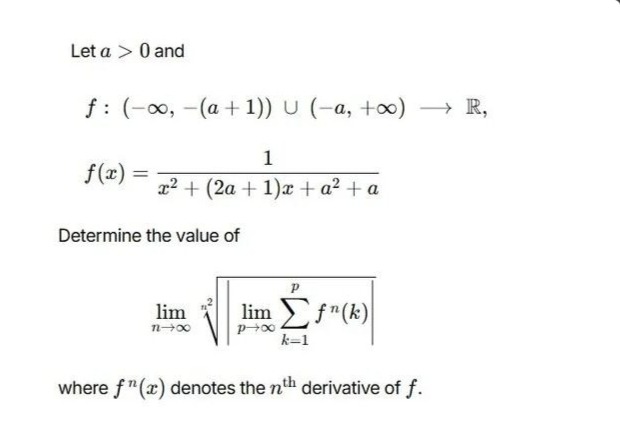Question
Question: Let $a > 0$ and $$f: (-\infty, -(a+1)) \cup (-a, +\infty) \rightarrow \mathbb{R},$$ $$f(x) = \frac{1...
Let a>0 and f:(−∞,−(a+1))∪(−a,+∞)→R, f(x)=x2+(2a+1)x+a2+a1 Determine the value of limn→∞n2∣limp→∞∑k=1pfn(k)∣ where fn(x) denotes the nth derivative of f.

1
Solution
The function f(x) can be simplified by factoring the denominator: x2+(2a+1)x+a2+a=(x+a)(x+a+1) So, f(x)=(x+a)(x+a+1)1 Using partial fraction decomposition, we get: f(x)=x+a1−x+a+11 The nth derivative of f(x) is: f(n)(x)=dxndn(x+a1)−dxndn(x+a+11) The nth derivative of (x+c)−1 is (x+c)n+1(−1)nn!. Thus, f(n)(x)=(−1)nn!((x+a)n+11−(x+a+1)n+11) Now, consider the inner limit: limp→∞∑k=1pfn(k)=limp→∞∑k=1p(−1)nn!((k+a)n+11−(k+a+1)n+11) This is a telescoping sum: =(−1)nn!limp→∞[((1+a)n+11−(2+a)n+11)+((2+a)n+11−(3+a)n+11)+⋯+((p+a)n+11−(p+1+a)n+11)] =(−1)nn!limp→∞((1+a)n+11−(p+1+a)n+11) As p→∞, (p+1+a)n+11→0. So, the limit of the sum is: (−1)nn!(1+a)n+11 Now, we take the absolute value: (−1)nn!(1+a)n+11=(1+a)n+1n! Finally, we evaluate the outer limit: L=limn→∞n2(1+a)n+1n!=limn→∞((1+a)n+1n!)n21 To evaluate this, we consider the logarithm: lnL=limn→∞n21ln((1+a)n+1n!)=limn→∞n2ln(n!)−(n+1)ln(1+a) We use the fact that ln(n!)≈nlnn−n (Stirling's approximation). lnL=limn→∞n2nlnn−n−(n+1)ln(1+a) lnL=limn→∞(n2nlnn−n2n−n2(n+1)ln(1+a)) lnL=limn→∞(nlnn−n1−n2(n+1)ln(1+a)) As n→∞: limn→∞nlnn=0 (by L'Hopital's rule). limn→∞n1=0. limn→∞n2(n+1)ln(1+a)=ln(1+a)limn→∞n2n+1=ln(1+a)⋅0=0. Therefore, lnL=0−0−0=0. Since lnL=0, we have L=e0=1.
